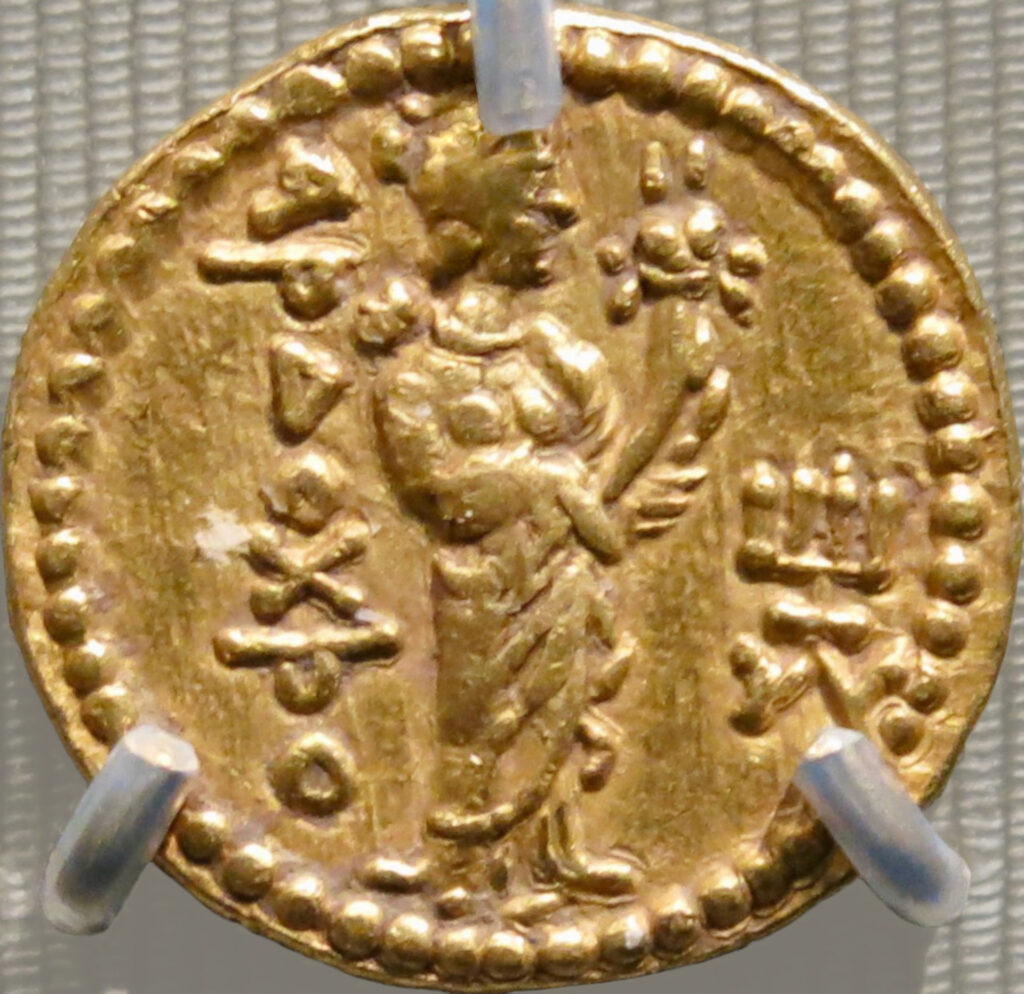Ardoksho (also spelled Ardochsho) was a deity who is best known for her appearances on gold coins of the Kushan (also spelled Kusana) Empire roughly two thousand years ago. The Kushan Empire included parts of today’s nations of Pakistan, Afghanistan, Uzbekistan, and the northern part of India. Contemporary empires included the Han Empire in what is now China, the Roman Empire, and the Parthian Empire between the Kushans and the Romans.

It may be that Ardoksho had never been represented visually prior to her appearance on Kushan gold coins:
“…Taken collectively, the coins of the Kusana include twenty-three (and possibly as many as thirty) confirmed different-named deities, most of whom seem to have been drawn from Iranian, indian, and Greek pantheons. Zeymal has argued that the vast majority of these have no known anthropomorphic form before their appearance on Kusana coins. He asserts that only three of the religious figures depicted on Kusana coins draw from preexistent figural forms, and one of these is the Buddha. However, the rest of the deities, such as Miiro, Mao, Ardochsho, Athsho, and Pharro, are unkonw in figural art before the intervention of the Kusana die cutters. While the exact motivation for this explosion in iconographic innovation is unknown, it is conceivably a by-product of Kusana cultural borrowing. In other words, after the tradition of minting coins with images of deities on the reverse was adopted, such practice was expected, and the coin makers were compelled to create forms for those gods that had no prior iconography….” (1)
Ardoksho was a fixture on Kushan coins for something like five hundred years. As a goddess of prosperity, she would have been a likely candidate for inclusion on a coin. Her origins are not entirely clear: she may be related to the ancient Greek goddess Demeter, or perhaps the ancient Greek goddess Tyche or the Roman goddess Fortuna; or she may have been her origins in a local goddess of eastern Iran known as Ardvi Sura Anahita, a goddess of water and moisture; and she is said by some sources to be the daughter of Ahuramazda. But Ardoksho’s iconography is fairly stable, always relating to prosperity and plenty: she was typically depicted holding a cornucopia or horn of plenty; a cornucopia and a wreath; a flower in her right hand and a wheat-stem in her left hand (not unlike Demeter); or a cornucopia in her right hand and a fillet in her left hand. (2)
Empires tend to bring different cultures together, which can lead to cross-cultural fertilization. Over the centuries she appeared on Kushan Empire coins, Ardoksho is one of the deities who engaged in cross-fertilization:
“…If Greeks were converted to Vaishnavism or came to accept the presence of Bhagavata and Shaiva deities, Indians began to worship deities from across the borders, some of which entered the Indian pantheon, such as the goddess Ardochso in the form of Shri….” (3)
Indeed, the Kushan Empire was quite tolerant of local deities and religious practices:
“Although the Kushans had a favored style of military architecture, it is clear they did not attempt to impose a single religious tradition on their empire but rather patronized key regional cults. Vima Kadphises’ son, Kanishka (127-147), thus dedicated a major ceremonial complex at Surkh Kotal in Afghanistan which combined dynastic statues with a [Zoroastrian] fire-temple but also established a major Buddhist stupa at Shahji-Dheri, in Peshawar to the south. His coinage demonstrates similar plurality, and he was equally happy to be portrayed with the Hellenistic deity Helios, the Iranian deity Adsho, and the Buddha, whose identities were confirmed in Greek script.” (4)
On the coin shown above, Ardoksho appears in the center, with her name written at left. I don’t think she’s holding a cornucopia; I believe on this coin she’s holding a flower in her right hand and what might be a wheat stem in her left hand.
Notes
(1) Robert Daniel DeCaroli, Image Problems: The Origin and Development of the Buddha’s Image in Early South Asia (University of Washington Press, 2015).
(2) Prashant Srivastava, A Dictionary of Divinities and Their Symbols on Ancient Indians Coins (WebGuruCool, 2022), pp. 10-11; excerpts from the earlier publication by Srivastava, Encyclopaedia of Indian Coins: Ancient Coins of Northern India up to c 650 AD, 2 vols. (Delhi: Agam Kala Prakashan, 2012). See also: British Museum website, “Ardochsho,” https://www.britishmuseum.org/collection/term/BIOG132101 accessed 3 Nov. 2023; this web page references J. Rosenfield, Dynastic Art of the Kushans (Berkeley, 1967), pp. 74-75.
(3) Romila Thapar, The Penguin History of Early India: From the Origins to AD 1300, p. 223.
(4) Robin Coningham and Mark Manuel, “The Early Empires of South Asia,” in The Great Empires of the Ancient World (London and New York: Thames & Hudson, 2009/2021), pp. 187-188.
Updated to add more info about Kushan religious plurality.
